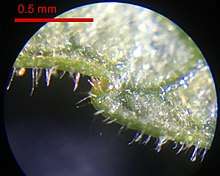Salicaceae
The Salicaceae are a family, the willow family, of flowering plants. The traditional family (Salicaceae sensu stricto) included the willows, poplar, aspen, and cottonwoods. Recent genetic studies summarized by the Angiosperm Phylogeny Group (APG) have greatly expanded the circumscription of the family to contain 56 genera and about 1220 species, including the Scyphostegiaceae and many of the former Flacourtiaceae.[4][5][6]
| Salicaceae | |
|---|---|
 | |
| Salix caprea | |
| Scientific classification | |
| Kingdom: | Plantae |
| Clade: | Tracheophytes |
| Clade: | Angiosperms |
| Clade: | Eudicots |
| Clade: | Rosids |
| Order: | Malpighiales |
| Family: | Salicaceae Mirb.[1] |
| Tribes[2][3] | |
| |
| Synonyms | |
| |
In the Cronquist system, the Salicaceae were assigned to their own order, Salicales, and contained three genera (Salix, Populus, and Chosenia). Now recognized to be closely related to the Violaceae and Passifloraceae, the family is placed by the APG in the order Malpighiales.


Under the new circumscription, all members of the family are trees or shrubs that have simple leaves with alternate arrangement and temperate members are usually deciduous. Most members have serrate or dentate leaf margins, and those that have such toothed margins all exhibit salicoid teeth; a salicoid tooth being one in which a vein enters the tooth, expands, and terminates at or near the apex, near which are spherical and glandular protuberances called setae. Members of the family often have flowers which are reduced and inconspicuous, and all have ovaries that are superior or half-inferior with parietal placentation.[7]
Genera by subfamily
- Samydoideae
- Casearia
- Euceraea
- Hecatostemon
- Irenodendron[8]
- Laetia
- Lunania
- Neoptychocarpus
- Ophiobotrys
- Osmelia
- Pseudosmelia
- Ryania
- Samyda
- Tetrathylacium
- Trichostephanus
- Zuelania
- Scyphostegioideae
- Salicoideae
- Abatia (including Aphaerema)[10]
- Ahernia
- Azara
- Banara
- Bartholomaea
- Bembicia
- Bennettiodendron
- Bivinia
- Byrsanthus
- Calantica
- Carrierea
- Dissomeria
- Dovyalis
- Flacourtia
- Hasseltia
- Hasseltiopsis
- Hemiscolopia
- Homalium
- Idesia
- Itoa
- Lasiochlamys
- Ludia
- Macrohasseltia
- Macrothumia[10]
- Neopringlea
- Neosprucea
- Olmediella
- Oncoba sensu stricto
- Pineda
- Pleuranthodendron
- Poliothyrsis
- Populus
- Prockia
- Pseudosalix†[11]
- Pseudoscolopia
- Salix
- Scolopia
- Tisonia
- Trimeria
- Xylosma (including Priamosia)[10]
References
- "Salicaceae Mirb., nom. cons". Germplasm Resources Information Network. United States Department of Agriculture. 2003-01-17. Retrieved 2010-02-04.
- Lemke, David (1988). "A synopsis of Flacourtiaceae". Aliso. 12 (1): 29–43. doi:10.5642/aliso.19881201.05. Retrieved 11 July 2018.
- "Family Salicaceae". Taxonomy. UniProt. Retrieved 2010-02-04.
- Chase, Mark W.; Sue Zmarzty; M. Dolores Lledó; Kenneth J. Wurdack; Susan M. Swensen; Michael F. Fay (2002). "When in doubt, put it in Flacourtiaceae: a molecular phylogenetic analysis based on plastid rbcL DNA sequences". Kew Bulletin. 57 (1): 141–181. doi:10.2307/4110825. JSTOR 4110825.
- Christenhusz, M. J. M. & Byng, J. W. (2016). "The number of known plants species in the world and its annual increase". Phytotaxa. Magnolia Press. 261 (3): 201–217. doi:10.11646/phytotaxa.261.3.1.
- Stevens, P. F. (2001 onwards). Angiosperm Phylogeny Website. Version 9, June 2008 (and more or less continuously updated since).
- Judd, Walter S. (January 2015). Plant systematics : a phylogenetic approach (Fourth ed.). Sunderland, MA. ISBN 978-1-60535-389-0. OCLC 920680553.
- Alford, Mac; Dement, Angela (2015). "Irenodendron, a new genus of Samydaceae from South America". Journal of the Botanical Research Institute of Texas. 9 (2): 331–334.
- Shang, Ce; Liao, Shuai; Guo, Yong-Jie; Zhang, Zhi-Xiang (2017). "Dianyuea gen. nov. (Salicaceae: Scyphostegioideae) from southwestern China". Nordic Journal of Botany. 35 (4): 499–505. doi:10.1111/njb.01363.
- Alford, Mac (2006). "Nomenclatural innovations in neotropical Salicaceae". Novon. 16 (3): 293–298. doi:10.3417/1055-3177(2006)16[293:niins]2.0.co;2.
- Boucher, L. D.; Manchester, S. R.; Judd, W. S. (2003). "An extinct genus of Salicaceae based on twigs with attached flowers, fruits, and foliage from the Eocene Green River Formation of Utah and Colorado, USA". American Journal of Botany. 90 (9): 1389–99. doi:10.3732/ajb.90.9.1389. PMID 21659238.
External links

